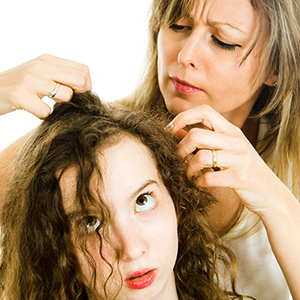Like most parents, I was horrified when I discovered my daughter had head
lice. But, as a pediatrician, I knew there was no real cause for alarm. The
head louse, or pediculus humanus capitis, is pesky, and maybe even
a little yucky, but essentially harmless. These tiny six-legged insects,
which cling to the scalp and live on small amounts of blood, do not spread
disease. They don’t jump or fly. And they don’t live more than a day or so
once they leave your scalp. So you can only spread them through
head-to-head contact, by using an infected person’s hat or hairbrush, or by
resting your head on a pillow or carpet where the infested person has
rested his or hers.
Head lice are also not a reflection on your family’s hygiene. Parents often
worry that a lice infestation means their child or their home is dirty, but
this is not true. Anyone who comes in head-to-head contact with someone
with lice is at risk, though infestations are most common among children
ages 3 to 11, especially girls (perhaps because of their long hair). They
are least common among African Americans, perhaps because lice are best
adapted to cling to certain types of hair shafts.
It’s also important to know that lice infestations can be easily
misdiagnosed. People frequently confuse the nits – the tiny white eggs laid
by lice that attach to the hair shaft near the scalp – with dandruff and
other debris. Unlike dandruff, though, nits are difficult to dislodge and
usually show up brown and pointed against a white background. But even
spotting nits does not mean you have an active infestation. Nits found more
than a quarter-inch away from the scalp have most likely already hatched,
and, in the absence of live lice, should not be treated.
So how are lice diagnosed?
Most lice infestations don’t cause immediate symptoms, though children may
complain of feeling things crawling around or tickling their heads. (It
sure makes me scratch my head as I write this.) If your child does have a
reaction – usually an itchy or irritated scalp – it will most likely occur
four to six weeks after infestation.
If you suspect lice, wet your child’s hair and go through it carefully with
a fine-toothed comb. Use a magnifying glass, if necessary, to scan for
live, moving insects, usually tan to grayish-white and about the size of a
sesame seed. Have a bowl of hot, soapy water ready to drown them as you
remove them with the comb.
Lice cling to the scalp and neck, especially around the ears or hairline.
Nits close to the scalp are the ones most likely to hatch. One way to
loosen them is by wetting the hair with a solution of half water, half
vinegar (unfiltered apple cider vinegar is a good choice).
If you do find live lice, other family members and children at school or
daycare who may have been exposed should also be checked. But don’t worry
about pets. Lice can’t live on animals because they need human blood to
survive.
Treating Head Lice
Standard treatment for head lice has long been the use of over-the-counter
products, including shampoos and lotions that contain the pesticides
permethrin or malathion. (Products with pyrethrins are also used, but can
cause reactions in people with chrysanthemum allergies.) Be sure to follow
the instructions carefully, and never use more than the recommended
amounts.
A few important points to remember: Sometimes these treatments must be
repeated to eliminate any surviving nits that have hatched since the
initial treatment. Also, some lice have become resistant to these
chemicals. Pesticides should never be used on infants.
Because many parents don’t want to use pesticides, I recommend removing
lice and viable nits by hand, with the same fine-toothed comb you use for
diagnosing them. Each infested member of the family should be treated at
the same time, and you should do the wet combing every three to four days
for three weeks after the last live louse is seen.
Because lice cannot survive more than 48 hours away from the scalp, you
don’t need to do a lot of house cleaning. But you should wash bedding and
clothing used by the affected child in very hot water, at least 130 degrees
Fahrenheit, and dry on high for 20 minutes. Pillows can also go into a hot
dryer. Combs and brushes can be soaked for an hour in rubbing alcohol. It
isn’t necessary to clean stuffed animals, but if you are concerned, you can
leave them in airtight bags for two weeks.
Some schools still routinely send children home if they show any signs of a
possible lice infestation, including nits, but we now know that is not
necessary. Most nits do not indicate an active infection, and we know that
spreading lice can be prevented by simply avoiding head-to-head contact.
Along these lines, it’s always good practice to discourage your kids from
sharing hairbrushes and combs, hats or sports helmets and hair ribbons or
barrettes.
A visit to your doctor is warranted only if you’ve treated the problem at
home and the lice keep coming back, or if your child has been scratching so
much that they’ve created sores that have become infected.
As a pediatrician, I tell parents not to worry about lice, but I do
understand their discomfort. When my daughter had lice, I wanted to scrub
my house from top to bottom. But as a physician, I told myself what I tell
my patients: This is normal. It’s manageable. I don’t need to fumigate. And
everything is going to be okay.
To find out more about preventing and treating head lice, visit the Centers
for Disease Control and Prevention’s website:
cdc.gov/parasites/lice.


